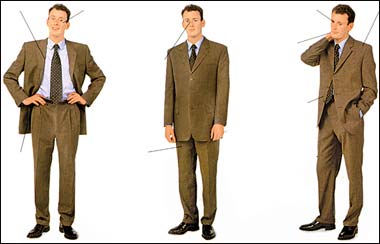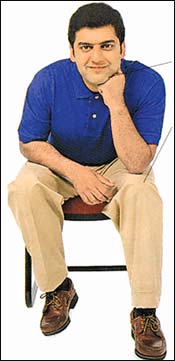|
Soft skills and professional excellence:
Non-verbal communication
Dr. K. Kuhathasan CEO: Cenlead
All verbal communication is affected by the non-verbal communication
that accompanies it. Face to face, expression, gestures and posture also
play an important part.
We use demonstrations and models to supplement words, visual aids to
clarify lectures, and maps, diagrams, charts and graphs enhance both
spoken and written communication.
|

Your preferred body positions and movements do say something
about the kind of person you are. If your words say one thing
and your body another, than people will believe your body, not
your words. |
Often more is conveyed by non-verbal than by verbal communication,
yet on the whole it is an aspect of communication that is little
considered.
Today, in several organizations, only people with excellent soft
skills are considered for Managerial positions.
The nature of non-verbal communication
The major elements of non-verbal communication, excluding models,
drawings can be divided into body language.
How body language communicates
Included under body language are facial expressions, gestures and
posture, smell and touch; all are noticeable non-verbal communication
symbols. Sometimes they are more meaningful than words, but we must be
careful when interpreting them in our daily interpersonal
communications.
They are important also for special occasions, interviews and
speeches to groups.
Facial expressions
The eyes and face are especially helpful means of communicating
non-verbally.
They can divulge hidden emotions-anger, annoyance, confusion,
enthusiasm, fear, hatred, joy, love, interest, sorrow, surprise,
uncertainty and others.
They can also contradict verbal statements.
It is obvious that facial expressions and use of gesture contribute
much to communication. As important, though perhaps less easy to
interpret, is posture.
The way we stand, or sit the position of the head, and hands, can
speak volumes.
For example, a dejected person tends to slump, shoulders bowed and
head low, while arms crossed and held tightly in front of one's chest
indicates a defensive mood. What is interesting is that much of this
body language is involuntary or unconscious. When we frown, look
puzzled, twist a pen nervously in our fingers, sprawl in a chair, run
upstairs, we can convey all sorts of obvious and subtle messages about
our emotions, understanding, attitudes and health.
Some people are more skilled at hiding these involuntary signs than
are others, but we all need to make the effort to do so at times,
principally to avoid giving an unfavourable picture of ourselves to
others and to avoid letting them feel that we are reacting unfavourably
to them.
How appearance communicates
Appearance conveys non-verbal impressions that affect recipients'
attitudes toward the verbal messages even before they read or hear them.
Effect on written messages
The envelopes overall appearance-size, colour, weight, postage-may
impress the receiver as "important," "routine," or "junk" mail.
Telegrams, Mailgrams, Express Mail and private courier mail also have
distinctive envelopes that signal urgency and importance. Next, the
letter report or title page communicates non-verbally even before its
contents are read.
Also important are the appearance of a messages stationery and its
length, format and typing. The enclosures-quantity and attractiveness
(with or without charts, graphs, pictures) also give significant
non-verbal impressions.
May people believe that the language of gesture is universal. Many
people believe that one picture is worth a thousand words, the
implication being that what we see is ever so much clearer than what is
said.
Many people believe that communication means speaking and that
misunderstandings only occur with speaking. Many people believe that
smiling and frowning and clapping are purely natural expressions.
Non-verbal communication
communication that doesn't use words-takes place all the time.
Smiles, frowns, who sits where at a meeting, the size of an office, how
long someone keeps a visitor waiting-all these communicate pleasure or
anger, friendliness or distance, power and status. Face-to-face commun
ication offers multiple non-verbal cues, and phone calls offer limited
non-verbal messages through tone of voice and pauses. Even written media
offer minimal non-verbal signals through visual impact.
Non-verbal communication can include the following signals:
Voice qualities
* Tone of voice
* Pitch
* Stress
* Volume
Body language
* Posture and movement
* Eye contact
* Facial expressions and emotion
* Gestures
* Greetings
Space
* Personal space
* Touching
* Spatial arrangements
Time
* Waiting and lead time
* Number of things that happen at the same time
Miscellaneous
* Clothing
*Colours
* Age
By controlling the non-verbal messages you send, you can project the
image you desire.

Non-verbal communication plays a role in business. For one thing, it
helps establish credibility and leadership potential. If you can learn
to manage the impression you create with your body langauge, facial
characteristics, voice and appearance, you can do a great deal to
communicate that you are competent, trustworthy and dynamic.
At the same time, if you can learn to read other people's non-verbal
messages, you will be able to interpret their underlying attitudes and
intentions more accurately. In dealing with co-workers, customers, and
clients, watch carefully for small signs that reveal how the
conversation is going. If you aren't having the effect you want, check
your words; then if your words are all right, try to be aware of the
non-verbal meanings you are transmitting.
At the same time, stay tuned to the non-verbal signals that the other
person is sending.
The varieties of nonverbal communication
For discussion purposes, however, these forms can be grouped into
general categories, which include facial expressions and eye behaviour,
gestures and postures, vocal characteristics, personal appearances,
touching behaviour, and use of time and space.
Researchers have drawn some interesting conclusions about the meaning
of certain non-verbal signals. But remember that the meaning of
non-verbal communication is in the observer, who reads the meaning of
specific signal and interprets in the context of the particular
situation.
Non-verbal messages may be more important than words
The functions of non-verbal communication
People use non-verbal signals to support and clarify verbal
communication. Although non-verbal communication can stand alone, it
frequently works hand in hand with speech.
Our words carry part of the message and non-verbal signals carry the
rest. Together, the two modes of expression make a powerful team,
augmenting, reinforcing, and clarifying each other.
For example, imagine that you are running a meeting.
You might clear your throat and straighten up in your chair as you
say, "I'd like to call the meeting to order now." Later you might hold
up three fingers and say, "There are three things we need to decide on
today."
As the meetings progresses, you might substitute gestures for
comments nodding your head and smiling to show approval, frowning to
express reservations.
You might also use non-verbal communication to regulate the flow of
conversation; by tilting your head, for example, you could invite a
colleague to continue with a comment. Finally, you might hedge your bets
by saying one thing but implying another non-verbally.
Experts in non-verbal communication suggest that it has six specific
functions:
* To provide information, either consciously or unconsciously
* To regulate the flow of conversation
* To express emotion
* To qualify, complement, contradict, or expand verbal messages
* To control or influence others
* To facilitate specific tasks, such as teaching a person
Common body signals
Psychologists and sales people know that arms folded across the chest
signify defiance and refusals. The following are some other body
language indicators which are especially common:
Action Meaning
Toes pointed outward - Confidence
Toes pointed inward - Submission
A jutting chin - Belligerence
Lip and nail biting - Disappointment/ Nervousness
Lip licking - Nervousness
Foot tapping - Impatience
Leaning backward - A relaxed attitude
Leaning forward - Interest
Open palms - Honesty
Rubbing hands together Excitement
Rubbing one eye -Deceit/Boredom
Scratching neck or head Uncertainty
Body Language
Use the following guidelines to make your body langauge more
effective.
* Posture - Your posture should be upright but not stiff. When
standing, keep your head up and shoulders back. Don't lean on the podium
or table as you speak. When sitting, avoid slumping. It makes you appear
to be uninterested and hurts your ability to produce effective sound.
* Movement - Move enough to show those with whom you are speaking
that your are energetic but avoid purposeless pacing or fidgeting.
* Gestures - Make your gestures purposeful, appropriate, smooth, and
economical. Keep them related to what you are saying. Avoid stilted,
artificial moments of hands and arms. Practise your speeches in front of
a mirror.
* Expression - Facial expressions such as gestures, can clarify
meaning and provide emphasis. Dealing with a serious subject with a
smile on your face or trying to suggest enthusiasm while your expression
is blank sends a confusing message. Practising before a mirror can help
you analyze how well you match your expressions to your thoughts.
* Eye contact - As you speak with people, concentrate on how they are
reacting to what you are saying. By looking for feedback from those with
whom you are speaking, you will be able not only to judge their
reactions but also to convince them of your interest.
Final tips on Body Language
* It has no words or sentences - but it does send bits of information
which combine into messages
* Those messages, which are sometimes clear and sometimes fuzzy, are
mostly about your feelings.
* People can learn to read those messages with a fair degree of
accuracy.
* Body langauge - you are sending messages non-verbally all the time.
* Your preferred body positions and movements do say something about
the kind of person you are.
* If your words say one thing and your body another, then people will
believe your body, not your words.
* You can change how you're feeling by consciously changing your body
langauge. |



